Road Transport and highways Minister Nitin Gadkari has launched a new Mobile App for users who frequently use highways. Name this app that ampowers frequent highway users with information.
Yaad Rakho
Safe Raasta
Suraksha
Sukhd Yatra
The correct Answer is:D
Similar Questions
Statement : the Govt has decided to construct an eight-lane superhighway across the state to facilitate fast movement of vehicles. Which of the following can be an assumption which is implicit in the above statement.?
1) The Govt has adequate resources to construct the proposed super highway.
2) The people of the state may protest against the Govt's decision as their farmland will be taken over by the Govt for constructing the highway.
3) The Govt may find it difficult to enroll a suitable contractor for constructing the highway.
4) There is no other highway which can be used for transportation of goods across the state.
5) None of these
View SolutionYou Are Where You Say
Research on regional variations in English-language use has not only yielded answers to such life-altering questions a show people in different parts of the United States refer to carbonated beverages (“soda”? “pop”? “coke”?) it also illustrate show technology can change the very nature of research. While traditional, human-intensive data collection has all but disappeared in language studies, the explosion ofsocial media has open edne wave nues for investigation. [1] Perhaps the epitome of traditional methodology is the Dictionary of American Regional English, colloquially known as DARE. [2] Its fifth and final alphabetical volume—ending with “zydeco”— released in 2012, the dictionary represents decade so far duous work. [3] Overa six-year period from 1965 to 1970, university graduate students conducted inter views in morethan a thousand communities across the nation. [4] Their goal was to determine what names people used for such every day object sand concepts as a submarine sandwich.
(a “hero” in New York City but a “dagwood”in many parts of Minnesota, Iow a, and Colorado) and a heavy rainstorm(variously a “gullywasher,” “pour-down,” or “stumpmover”). [5] The work that dictionary founder Frederic G. Cassidy had expected to be finished by 1976 was not,in fact, completed in his life time. [6] The wait did not dampen enthusiasm among scholars. Scholars consider the work a signal achievement in linguistics. Not all research into regional English varieties requires such time, effort, and resources, however. Today’s researchers have foundth at the veritable army of trained volunteer straveling the country conducting face-to- face inter view scan sometimes be replaced by another army the vastarray of individuals volunteering details about their lives— and,in advertently, their language— through social media. Brice Russ of Ohio State University,for example, has employed software to sort through postings on one social media cite in search of particular words and phrases of interest as well as the location from which users are posting. From these data,
he was able, among other things, to confirm regional variations in people's terms for soft drinks. As the map shows. ,“soda” is comm only heard in the middle and western portions of the United States, “pop” is frequently used in many southern states, and “coke”ispre dominant in the north eastern and south west region sbutused else where as well. As interesting as Russ’s findings are, though, they’re true value lies in their reminder that the Internet is not merelya sophisticated tool for collecting data but is also itself a rich source of data

Which choice most effectively sets up the contrast in the sentence and is consistent with the information in the rest of the passage?
View Solution
Knowledge Check
Union Minister for Road Transport & Highways, Shipping Nitin Gadkari inaugurated a 1210-meter span-bridge over the river .......... in Kathua district of Jarnrnu & Kashmir on Jan 2019.
AJhelumBChenabCRaviDSutlejConsider the following statements
1. Shipping Samvad is a website launched by Union Ministry of Shipping, Road Transport & Highways.
2. The ideas and suggestions submitted by public and experts will be further examined for implementation by Ministry of Shipping.
3. Website’s objective is to invite innovative ideas and suggestions from general public and experts related to Indian maritime sector for improvements in the ports, shipping and inland waterways sector.
Which of the statements given above is/are correct?A1 & 2 onlyB2 & 3 onlyCAll of the aboveDNone of the aboveYou Are Where You Say
Research on regional variations in English-language use has not only yielded answers to such life-altering questions a show people in different parts of the United States refer to carbonated beverages (“soda”? “pop”? “coke”?) it also illustrate show technology can change the very nature of research. While traditional, human-intensive data collection has all but disappeared in language studies, the explosion ofsocial media has open edne wave nues for investigation. [1] Perhaps the epitome of traditional methodology is the Dictionary of American Regional English, colloquially known as DARE. [2] Its fifth and final alphabetical volume—ending with “zydeco”— released in 2012, the dictionary represents decade so far duous work. [3] Overa six-year period from 1965 to 1970, university graduate students conducted inter views in morethan a thousand communities across the nation. [4] Their goal was to determine what names people used for such every day object sand concepts as a submarine sandwich.
(a “hero” in New York City but a “dagwood”in many parts of Minnesota, Iow a, and Colorado) and a heavy rainstorm(variously a “gullywasher,” “pour-down,” or “stumpmover”). [5] The work that dictionary founder Frederic G. Cassidy had expected to be finished by 1976 was not,in fact, completed in his life time. [6] The wait did not dampen enthusiasm among scholars. Scholars consider the work a signal achievement in linguistics. Not all research into regional English varieties requires such time, effort, and resources, however. Today’s researchers have foundth at the veritable army of trained volunteer straveling the country conducting face-to- face inter view scan sometimes be replaced by another army the vastarray of individuals volunteering details about their lives— and,in advertently, their language— through social media. Brice Russ of Ohio State University,for example, has employed software to sort through postings on one social media cite in search of particular words and phrases of interest as well as the location from which users are posting. From these data,
he was able, among other things, to confirm regional variations in people's terms for soft drinks. As the map shows. ,“soda” is comm only heard in the middle and western portions of the United States, “pop” is frequently used in many southern states, and “coke”ispre dominant in the north eastern and south west region sbutused else where as well. As interesting as Russ’s findings are, though, they’re true value lies in their reminder that the Internet is not merelya sophisticated tool for collecting data but is also itself a rich source of data
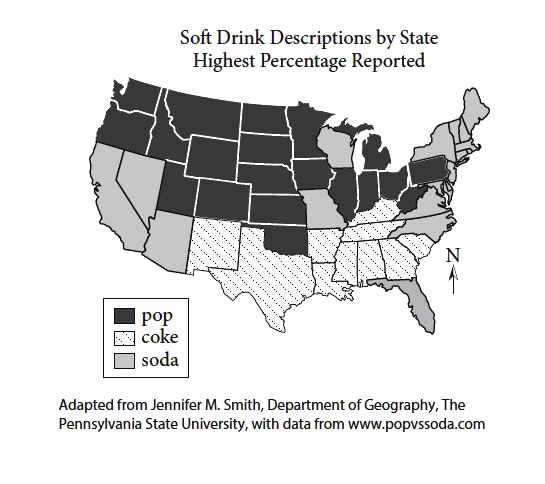 ANo ChangeBand also illustratesCbut also illustratesDillustrating
ANo ChangeBand also illustratesCbut also illustratesDillustrating
You Are Where You Say
Research on regional variations in English-language use has not only yielded answers to such life-altering questions a show people in different parts of the United States refer to carbonated beverages (“soda”? “pop”? “coke”?) it also illustrate show technology can change the very nature of research. While traditional, human-intensive data collection has all but disappeared in language studies, the explosion ofsocial media has open edne wave nues for investigation. [1] Perhaps the epitome of traditional methodology is the Dictionary of American Regional English, colloquially known as DARE. [2] Its fifth and final alphabetical volume—ending with “zydeco”— released in 2012, the dictionary represents decade so far duous work. [3] Overa six-year period from 1965 to 1970, university graduate students conducted inter views in morethan a thousand communities across the nation. [4] Their goal was to determine what names people used for such every day object sand concepts as a submarine sandwich.
(a “hero” in New York City but a “dagwood”in many parts of Minnesota, Iow a, and Colorado) and a heavy rainstorm(variously a “gullywasher,” “pour-down,” or “stumpmover”). [5] The work that dictionary founder Frederic G. Cassidy had expected to be finished by 1976 was not,in fact, completed in his life time. [6] The wait did not dampen enthusiasm among scholars. Scholars consider the work a signal achievement in linguistics. Not all research into regional English varieties requires such time, effort, and resources, however. Today’s researchers have foundth at the veritable army of trained volunteer straveling the country conducting face-to- face inter view scan sometimes be replaced by another army the vastarray of individuals volunteering details about their lives— and,in advertently, their language— through social media. Brice Russ of Ohio State University,for example, has employed software to sort through postings on one social media cite in search of particular words and phrases of interest as well as the location from which users are posting. From these data,
he was able, among other things, to confirm regional variations in people's terms for soft drinks. As the map shows. ,“soda” is comm only heard in the middle and western portions of the United States, “pop” is frequently used in many southern states, and “coke”ispre dominant in the north eastern and south west region sbutused else where as well. As interesting as Russ’s findings are, though, they’re true value lies in their reminder that the Internet is not merelya sophisticated tool for collecting data but is also itself a rich source of data
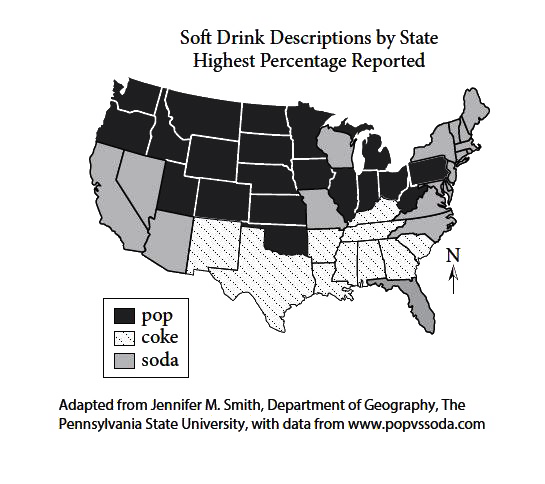
View SolutionYou Are Where You Say
Research on regional variations in English-language use has not only yielded answers to such life-altering questions a show people in different parts of the United States refer to carbonated beverages (“soda”? “pop”? “coke”?) it also illustrate show technology can change the very nature of research. While traditional, human-intensive data collection has all but disappeared in language studies, the explosion ofsocial media has open edne wave nues for investigation. [1] Perhaps the epitome of traditional methodology is the Dictionary of American Regional English, colloquially known as DARE. [2] Its fifth and final alphabetical volume—ending with “zydeco”— released in 2012, the dictionary represents decade so far duous work. [3] Overa six-year period from 1965 to 1970, university graduate students conducted inter views in morethan a thousand communities across the nation. [4] Their goal was to determine what names people used for such every day object sand concepts as a submarine sandwich.
(a “hero” in New York City but a “dagwood”in many parts of Minnesota, Iow a, and Colorado) and a heavy rainstorm(variously a “gullywasher,” “pour-down,” or “stumpmover”). [5] The work that dictionary founder Frederic G. Cassidy had expected to be finished by 1976 was not,in fact, completed in his life time. [6] The wait did not dampen enthusiasm among scholars. Scholars consider the work a signal achievement in linguistics. Not all research into regional English varieties requires such time, effort, and resources, however. Today’s researchers have foundth at the veritable army of trained volunteer straveling the country conducting face-to- face inter view scan sometimes be replaced by another army the vastarray of individuals volunteering details about their lives— and,in advertently, their language— through social media. Brice Russ of Ohio State University,for example, has employed software to sort through postings on one social media cite in search of particular words and phrases of interest as well as the location from which users are posting. From these data,
he was able, among other things, to confirm regional variations in people's terms for soft drinks. As the map shows. ,“soda” is comm only heard in the middle and western portions of the United States, “pop” is frequently used in many southern states, and “coke”ispre dominant in the north eastern and south west region sbutused else where as well. As interesting as Russ’s findings are, though, they’re true value lies in their reminder that the Internet is not merelya sophisticated tool for collecting data but is also itself a rich source of data

View SolutionYou Are Where You Say
Research on regional variations in English-language use has not only yielded answers to such life-altering questions a show people in different parts of the United States refer to carbonated beverages (“soda”? “pop”? “coke”?) it also illustrate show technology can change the very nature of research. While traditional, human-intensive data collection has all but disappeared in language studies, the explosion ofsocial media has open edne wave nues for investigation. [1] Perhaps the epitome of traditional methodology is the Dictionary of American Regional English, colloquially known as DARE. [2] Its fifth and final alphabetical volume—ending with “zydeco”— released in 2012, the dictionary represents decade so far duous work. [3] Overa six-year period from 1965 to 1970, university graduate students conducted inter views in morethan a thousand communities across the nation. [4] Their goal was to determine what names people used for such every day object sand concepts as a submarine sandwich.
(a “hero” in New York City but a “dagwood”in many parts of Minnesota, Iow a, and Colorado) and a heavy rainstorm(variously a “gullywasher,” “pour-down,” or “stumpmover”). [5] The work that dictionary founder Frederic G. Cassidy had expected to be finished by 1976 was not,in fact, completed in his life time. [6] The wait did not dampen enthusiasm among scholars. Scholars consider the work a signal achievement in linguistics. Not all research into regional English varieties requires such time, effort, and resources, however. Today’s researchers have foundth at the veritable army of trained volunteer straveling the country conducting face-to- face inter view scan sometimes be replaced by another army the vastarray of individuals volunteering details about their lives— and,in advertently, their language— through social media. Brice Russ of Ohio State University,for example, has employed software to sort through postings on one social media cite in search of particular words and phrases of interest as well as the location from which users are posting. From these data,
he was able, among other things, to confirm regional variations in people's terms for soft drinks. As the map shows. ,“soda” is comm only heard in the middle and western portions of the United States, “pop” is frequently used in many southern states, and “coke”ispre dominant in the north eastern and south west region sbutused else where as well. As interesting as Russ’s findings are, though, they’re true value lies in their reminder that the Internet is not merelya sophisticated tool for collecting data but is also itself a rich source of data
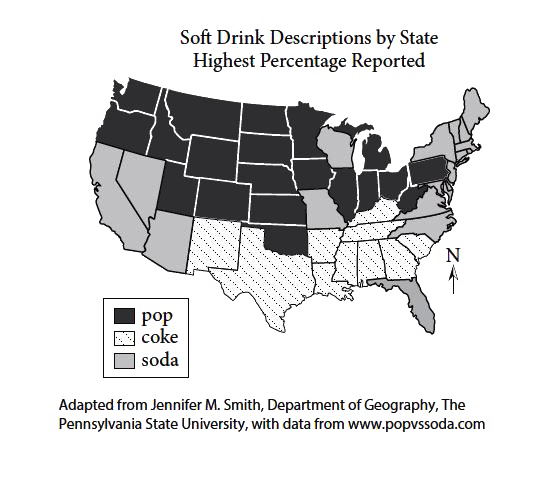
View SolutionYou Are Where You Say
Research on regional variations in English-language use has not only yielded answers to such life-altering questions a show people in different parts of the United States refer to carbonated beverages (“soda”? “pop”? “coke”?) it also illustrate show technology can change the very nature of research. While traditional, human-intensive data collection has all but disappeared in language studies, the explosion ofsocial media has open edne wave nues for investigation. [1] Perhaps the epitome of traditional methodology is the Dictionary of American Regional English, colloquially known as DARE. [2] Its fifth and final alphabetical volume—ending with “zydeco”— released in 2012, the dictionary represents decade so far duous work. [3] Overa six-year period from 1965 to 1970, university graduate students conducted inter views in morethan a thousand communities across the nation. [4] Their goal was to determine what names people used for such every day object sand concepts as a submarine sandwich.
(a “hero” in New York City but a “dagwood”in many parts of Minnesota, Iow a, and Colorado) and a heavy rainstorm(variously a “gullywasher,” “pour-down,” or “stumpmover”). [5] The work that dictionary founder Frederic G. Cassidy had expected to be finished by 1976 was not,in fact, completed in his life time. [6] The wait did not dampen enthusiasm among scholars. Scholars consider the work a signal achievement in linguistics. Not all research into regional English varieties requires such time, effort, and resources, however. Today’s researchers have foundth at the veritable army of trained volunteer straveling the country conducting face-to- face inter view scan sometimes be replaced by another army the vastarray of individuals volunteering details about their lives— and,in advertently, their language— through social media. Brice Russ of Ohio State University,for example, has employed software to sort through postings on one social media cite in search of particular words and phrases of interest as well as the location from which users are posting. From these data,
he was able, among other things, to confirm regional variations in people's terms for soft drinks. As the map shows. ,“soda” is comm only heard in the middle and western portions of the United States, “pop” is frequently used in many southern states, and “coke”ispre dominant in the north eastern and south west region sbutused else where as well. As interesting as Russ’s findings are, though, they’re true value lies in their reminder that the Internet is not merelya sophisticated tool for collecting data but is also itself a rich source of data
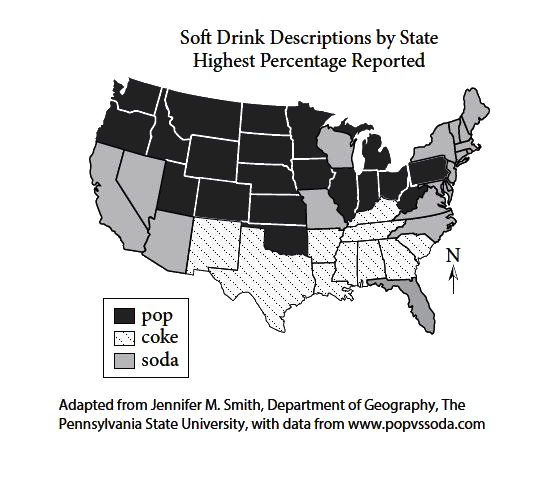
View SolutionYou Are Where You Say
Research on regional variations in English-language use has not only yielded answers to such life-altering questions a show people in different parts of the United States refer to carbonated beverages (“soda”? “pop”? “coke”?) it also illustrate show technology can change the very nature of research. While traditional, human-intensive data collection has all but disappeared in language studies, the explosion ofsocial media has open edne wave nues for investigation. [1] Perhaps the epitome of traditional methodology is the Dictionary of American Regional English, colloquially known as DARE. [2] Its fifth and final alphabetical volume—ending with “zydeco”— released in 2012, the dictionary represents decade so far duous work. [3] Overa six-year period from 1965 to 1970, university graduate students conducted inter views in morethan a thousand communities across the nation. [4] Their goal was to determine what names people used for such every day object sand concepts as a submarine sandwich.
(a “hero” in New York City but a “dagwood”in many parts of Minnesota, Iow a, and Colorado) and a heavy rainstorm(variously a “gullywasher,” “pour-down,” or “stumpmover”). [5] The work that dictionary founder Frederic G. Cassidy had expected to be finished by 1976 was not,in fact, completed in his life time. [6] The wait did not dampen enthusiasm among scholars. Scholars consider the work a signal achievement in linguistics. Not all research into regional English varieties requires such time, effort, and resources, however. Today’s researchers have foundth at the veritable army of trained volunteer straveling the country conducting face-to- face inter view scan sometimes be replaced by another army the vastarray of individuals volunteering details about their lives— and,in advertently, their language— through social media. Brice Russ of Ohio State University,for example, has employed software to sort through postings on one social media cite in search of particular words and phrases of interest as well as the location from which users are posting. From these data,
he was able, among other things, to confirm regional variations in people's terms for soft drinks. As the map shows. ,“soda” is comm only heard in the middle and western portions of the United States, “pop” is frequently used in many southern states, and “coke”ispre dominant in the north eastern and south west region sbutused else where as well. As interesting as Russ’s findings are, though, they’re true value lies in their reminder that the Internet is not merelya sophisticated tool for collecting data but is also itself a rich source of data
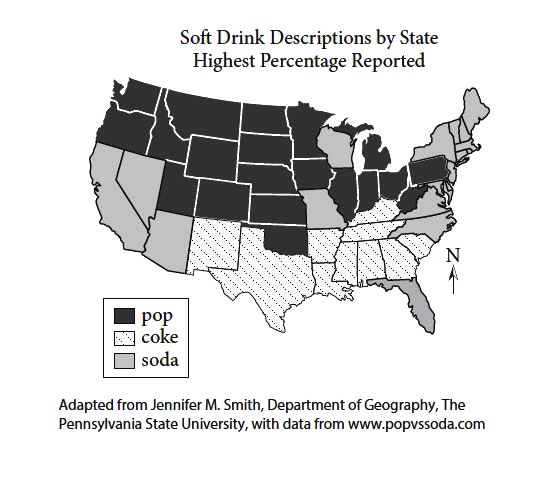
View Solution
